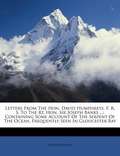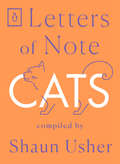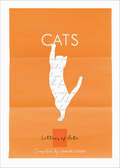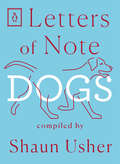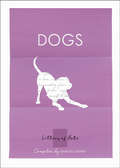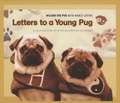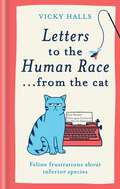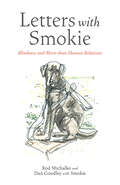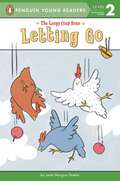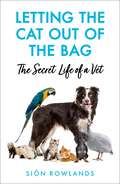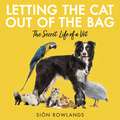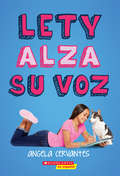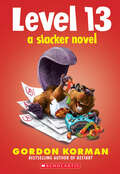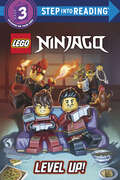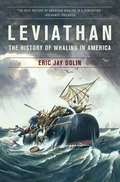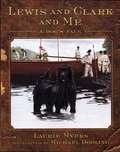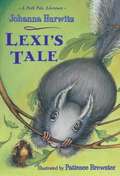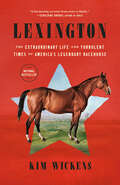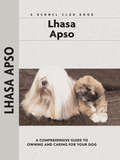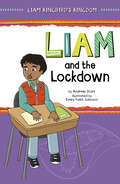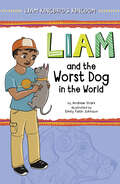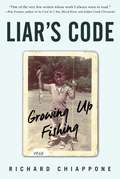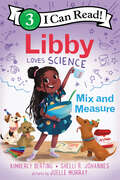- Table View
- List View
Letters from the Hon David Humphreys, F R S to the Rt Hon Sir Joseph Banks: Containing Some Account of the Serpent of the Ocean, Frequently Seen in Gloucester Bay
by David HumphreysThis is a reproduction of a book published before 1923. This book may have occasional imperfections such as missing or blurred pages, poor pictures, errant marks, etc. that were either part of the original artifact, or were introduced by the scanning process. We believe this work is culturally important, and despite the imperfections, have elected to bring it back into print as part of our continuing commitment to the preservation of printed works worldwide. We appreciate your understanding of the imperfections in the preservation process, and hope you enjoy this valuable book.
Letters of Note: Cats (Letters of Note #1)
by Shaun UsherAn irresistible new volume of affectionate missives about our feline companions from Charles Dickens, Anne Frank, Raymond Chandler, Elizabeth Taylor, and more, from the author of the bestselling Letters of Note collectionsFlorence Nightingale sends care instructions to the woman who has just adopted her angora tomcat Mr. White. T. S. Eliot issues a rhyming birthday party invitation to all Jellicle cats for his four-year-old godson. Jack Kerouac's mother grieves at the death of the family cat. Jack Lemmon winkingly suggests to Walter Matthau that they go in on a cat ranch in Mexico. This utterly charming collection offers a warm and friendly look at the place that cats occupy in our hearts and lives. These thirty letters capture the profound delight of having or observing a cat, and they reveal a keen insight into feline nature as well as our own.
Letters of Note: Cats (Letters of Note)
by Shaun UsherAn irresistible feline-themed selection of letters from the curator of the globally popular Letters of Note website.The first volume in the bestselling Letters of Note series was a collection of hundreds of the world's most entertaining, inspiring, and unusual letters, based on the seismically popular website of the same name--an online museum of correspondence visited by over 70 million people. From Virginia Woolf's heartbreaking suicide letter, to Queen Elizabeth II's recipe for drop scones sent to President Eisenhower; from the first recorded use of the expression 'OMG' in a letter to Winston Churchill, to Gandhi's appeal for calm to Hitler; and from Iggy Pop's beautiful letter of advice to a troubled young fan, to Leonardo da Vinci's remarkable job application letter. Now, the curator of Letters of Note, Shaun Usher, gives us wonderful new volumes featuring letters organized around a universal theme.In this volume, Shaun Usher turns to the cat--a subject of fascination, amusement, reverence, and joy. Even before they reigned supreme on the internet, their idiosyncratic ways and hold on our affections had long been written about in many forms. Letters of Note: collects together the most engaging missives that celebrate eulogize, rail against and analyze the ways of our feline companions. Includes letters by Nikola Tesla, Rachel Carson, Anne Frank, John Cheever, and many more.
Letters of Note: Dogs (Letters of Note #9)
by Shaun UsherAn irresistible new volume of affectionate missives about our man's best friend from the author of the bestselling Letters of Note collections.In Letters of Note: Dogs, Shaun Usher brings together a delightful collection of correspondence about our canine friends, featuring affectionate accounts of pups' playful misdemeanours, heartfelt tributes to loyal fidos and shared tales of remarkable hounds.Includes letters by:Clara Bow, Bob Hope,Charles Lamb, Sue Perkins,Marcel Proust, Dodie Smith,Gertrude Stein, E.B. White& many more
Letters of Note: Dogs (Letters of Note)
by Shaun UsherA charming collection of letters celebrating our beloved companions curated by the founder of the globally popular Letters of Note website. The first volume in the bestselling Letters of Note series was a collection of hundreds of the world's most entertaining, inspiring, and unusual letters, based on the seismically popular website of the same name--an online museum of correspondence visited by over 70 million people. From Virginia Woolf's heartbreaking suicide letter, to Queen Elizabeth II's recipe for drop scones sent to President Eisenhower; from the first recorded use of the expression 'OMG' in a letter to Winston Churchill, to Gandhi's appeal for calm to Hitler; and from Iggy Pop's beautiful letter of advice to a troubled young fan, to Leonardo da Vinci's remarkable job application letter. Now, the curator of Letters of Note, Shaun Usher, gives us wonderful new volumes featuring letters organized around a universal theme. In this volume, Shaun Usher turns to our beloved companions: dogs. Includes letters by Clara Bow, Bob Hope, Charles Lamb, Sue Perkins, Marcel Proust, Gertrude Stein, E.B. White and many more.
Letters to a Young Pug (Tao of Pug)
by Nancy Levine Wilson The PugOtto, the sage old pup who taught Wilson the ways of the Tao-te Ching, the ancient Chinese book of wisdom, is finally ready to rest his bones and retire to Boca Raton. Wilson is next in line to take his place as Master of the Taoist put lineage, but before he can assume his rightful position, he must train his own successor, the young pup Homer. Once Homer has learned the lessons of the Tao and earned his yin-yang badge, Wilson can take his place on Otto’s throne. Through funny letters and charming photographs, Wilson convers with his apprentice on the subtle wisdom of the Tao-te Ching. But unfortunately for Wilson, Homer’s not the easiest pupil to teach. He’s more interested in filling his stomach than feeding his mind. And he’d rather nap his way to wisdom. The young pug’s path to enlightenment is chock full of surprises, as Wilson is about to find out.
Letters to the Human Race… from the cat: Feline frustrations about inferior species
by Vicky HallsDear Human Race,It is with much regret, and a huge sigh of frustration, that I am writing this letter.For generations you have been taking our goodwill for granted but it behoves me, as a representative for my species, to say 'enough is enough'. You are unpredictable and inconsistent, often behaving in a way that is illogical to us and frankly unhygienic (all that touching!). I believe the modern phrase is 'You just don't get me!'Well, no more. My fellow felines and I have put pen to paper and paw to keyboard to write a series of letters that I believe will put you on the path to understanding where you've gone wrong. We feel we have covered most of your most common errors - from the food you give us (both the lack of quality and quantity) and your insistence on having other cats (and even dogs) in the house, to your bizarre toilet habits and our obsession with your socks.Consider this your performance review from cats... and you don't come out well.Yours sincerely,Sidney Fishbone, Esq.
Letters to the Human Race… from the cat: Feline frustrations about inferior species
by Vicky HallsDear Human Race,It is with much regret, and a huge sigh of frustration, that I am writing this letter.For generations you have been taking our goodwill for granted but it behoves me, as a representative for my species, to say 'enough is enough'. You are unpredictable and inconsistent, often behaving in a way that is illogical to us and frankly unhygienic (all that touching!). I believe the modern phrase is 'You just don't get me!'Well, no more. My fellow felines and I have put pen to paper and paw to keyboard to write a series of letters that I believe will put you on the path to understanding where you've gone wrong. We feel we have covered most of your most common errors - from the food you give us (both the lack of quality and quantity) and your insistence on having other cats (and even dogs) in the house, to your bizarre toilet habits and our obsession with your socks.Consider this your performance review from cats... and you don't come out well.Yours sincerely,Sidney Fishbone, Esq.
Letters with Smokie: Blindness and More-than-Human Relations
by Rod Michalko Dan GoodleyLeave it to a dog to put the “human” back in “humanities” In September 2020, Rod Michalko wrote to friend and colleague Dan Goodley, congratulating him on the release of his latest book, Disability and Other Human Questions. Joking that his late guide dog, Smokie, had taken offense to the suggestion that disability was purely a human question, Michalko shared a few thoughts on behalf of his dog. When Goodley wrote back—to Smokie—so began an epistolic exchange that would continue for the next seven months. As the COVID-19 pandemic swept across the world and the realities of lockdown-imposed isolation set in, the Smokie letters provided the friends a space in which to come together in a lively exploration of human-animal relationships and to interrogate disability as disruption, disturbance, and art. Just as he did in life, Smokie guides. In these pages, he offers wisdom about the world, love, friendship, and even The Beatles. His canine observations of human experience provide an avenue into some of the ways blindness might be reconceptualized and “befriended.” Uninhibited by the trappings of traditional academic inquiry, Michalko and Goodley are unleashed, free to wander, to wonder, and to provoke within the bonds of trust and respect. Funny and thoughtful, the result is a refreshing exploration and re-evaluation of learned cultural misunderstandings of disability.
Letting Go (The Loopy Coop Hens)
by Janet Morgan StoekeGo on a laugh-out-loud adventure with the hens of Loopy Coop Farm.Pip, Midge, and Dot, the lovable, goofy hens of Loopy Coop Farm, are back in their third adventure. This time they wrestle with the age old question: Why do apples fall? On their way to their own unique conclusion, they are first scared silly, then end up just acting silly. Showing bravery, curiosity, and loyalty to each other, these three irresistible hens will inspire young ones to face their own funny fears.With easy-to-read text and charmingly comic illustrations, this read-aloud is the perfect combination of sweetness and whimsy.
Letting the Cat Out of the Bag: The Secret Life of a Vet
by Siôn RowlandsTrimming a parrot's beak, emptying a dog's anal glands and neutering a cat - then lunch - followed by some tricky horse dentistry, amputating a lamb's leg and calming a distressed client... It's all in a day's work if you're a vet: a delicate balance of managing animal welfare and ethics, educating people in pet ownership and aligning their expectations with real-life outcomes. As a job, it spans everything from managing the heartbreak of euthanasia, to informing owners that under no circumstances should they take their dog's worming pills, even if they're sure they have worms. During his twenty-five-year career, Welsh vet Siôn Rowlands has experienced almost every animal medical issue imaginable, from rescuing an injured horse from the edge of a cliff to moisturizing a baby elephant. He's also witnessed ridiculous moments, surreal situations and the real toll it can take on a person. Frank, funny and moving in equal measure, Letting the Cat Out of the Bag is a rare glimpse behind the scenes of the uniquely pressurised world of being a vet.
Letting the Cat Out of the Bag: The Secret Life of a Vet
by Siôn RowlandsA sneak peek behind the professional veneer of vets, sprinkled with wacky moments, wicked humour, and a cornucopia of beloved animals.Trimming a parrot's beak, emptying a dog's anal glands and neutering a cat - then lunch - followed by some tricky horse dentistry, amputating a lamb's leg and calming a distressed client... It's all in a day's work if you're a vet: a delicate balance of managing animal welfare and ethics, educating people in pet ownership and aligning their expectations with real-life outcomes. As a job, it spans everything from managing the heartbreak of euthanasia, to informing owners that under no circumstances should they take their dog's worming pills, even if they're sure they have worms. During his twenty-five-year career, Welsh vet Siôn Rowlands has experienced almost every animal medical issue imaginable, from rescuing an injured horse from the edge of a cliff to moisturizing a baby elephant. He's also witnessed ridiculous moments, surreal situations and the real toll it can take on a person. Frank, funny and moving in equal measure, Letting the Cat Out of the Bag is a rare glimpse behind the scenes of the uniquely pressurised world of being a vet.(P) 2023 Hodder & Stoughton Limited
Lety alza su voz (Scholastic En Espanol-spanish Ser.)
by Angela CervantesCelebrated author Angela Cervantes returns to the fan favorite animal shelter featured in Gaby, Lost and Found, with a heartfelt novel about friendship and finding your voice.¡La version en espanol de Lety Out Loud!La lengua maternal de Lety Munoz es el espanol, y a ella le gusta pasar el tiempo juntando palabras. Tambien le gusta hacer de voluntaria en el refugio de animales, porque a los perros y gatos no les importa que a veces ella no encuentre la palabra apropiada.Lety Munoz's first language is Spanish, and she likes to take her time putting her words together. She loves volunteering at the Furry Friends Animal Shelter because the dogs and cats there don't care if she can't always find the right word.
Level 13: A Slacker Novel (Slacker)
by Gordon KormanFrom the bestselling author of Swindle, Restart, and Slacker is another hilarious story about an underachiever who learns to go above and beyond.Cameron Boxer, king of the slackers, has found something worth his time. By playing video games online in front of an audience he can find both fame AND fortune -- especially with Elvis (a beaver who seems to love video games as much as Cam) at his side.The only problem? Things keep getting in Cam's way. Like school. And the club he accidentally started. And the misguided people in his life who don't think beavers should be playing video games.It's going to take some trickery, some close calls, and a fierce devotion to slacking in order for Cam to get to his goal -- conquering the game's infamous Level 13. But if any slacker can do it, Cam can.
Level Up! (Step into Reading)
by Random HouseThe action-packed worlds of LEGO® NINJAGO® and video games collide in this Step into Reading Step 3 leveled reader that makes learning to read fun and exciting!Kai&’s and Ray&’s ninja skills are put to the test when bad guys interrupt their video game. Will father and son be able to level up, or is it game over for the ninjas? Fans of LEGO® NINJAGO® will love seeing their favorite characters in action while they also learn to read in this Step 3 leveled reader!Step 3 readers feature engaging characters in easy-to-follow plots about popular topics for children who are ready to read on their own.LEGO, the LEGO logo, the Brick and Knob configurations and the Minifigure are trademarks and/or copyrights of the LEGO Group. ©2023 The LEGO Group. All rights reserved.
Leviathan: The History of Whaling in America
by Eric Jay DolinA Los Angeles Times Best Non-Fiction Book of 2007 A Boston Globe Best Non-Fiction Book of 2007 Amazon.com Editors pick as one of the 10 best history books of 2007 Winner of the 2007 John Lyman Award for U. S. Maritime History, given by the North American Society for Oceanic History "The best history of American whaling to come along in a generation." --Nathaniel Philbrick The epic history of the "iron men in wooden boats" who built an industrial empire through the pursuit of whales. "To produce a mighty book, you must choose a mighty theme," Herman Melville proclaimed, and this absorbing history demonstrates that few things can capture the sheer danger and desperation of men on the deep sea as dramatically as whaling. Eric Jay Dolin begins his vivid narrative with Captain John Smith's botched whaling expedition to the New World in 1614. He then chronicles the rise of a burgeoning industry--from its brutal struggles during the Revolutionary period to its golden age in the mid-1800s when a fleet of more than 700 ships hunted the seas and American whale oil lit the world, to its decline as the twentieth century dawned. This sweeping social and economic history provides rich and often fantastic accounts of the men themselves, who mutinied, murdered, rioted, deserted, drank, scrimshawed, and recorded their experiences in journals and memoirs. Containing a wealth of naturalistic detail on whales, Leviathan is the most original and stirring history of American whaling in many decades.
Lewis and Clark and Me: A Dog's Tale
by Laurie MyersSeaman, Meriwether Lewis's Newfoundland dog, describes Lewis and Clark's expedition which he accompanied from St. Louis to the Pacific Ocean.
Lexi's Tale
by Johanna Hurwitz Patience BrewsterLexi the squirrel doesn't trust humans. After all, it was a human who abandoned PeeWee the guinea pig in Central Park. So Lexi is outraged when a strange-looking man swipes the apple that the friends were about to eat. But when the stranger rescues PeeWee from the jaws of a dog, Lexi has a change of heart. Can two rodents make a difference in the life of a man living hungry and friendless in Central Park? Welcome back the street-smart squirrel and the well-read guinea pig in this stand-alone companion to PeeWee's Tale, which Publishers Weekly called "humorous and insightful."
Lexington: The Extraordinary Life and Turbulent Times of America's Legendary Racehorse
by Kim WickensNATIONAL BESTSELLER • &“A vivid portrait of America&’s greatest stallion, the larger-than-life men who raced and bred him, and the dramatic times in which they lived.&”—Geraldine Brooks, author of HorseThe powerful true story of the champion Thoroughbred racehorse who gained international fame in the tumultuous Civil War–era South, and became the most successful sire in American racing historyThe early days of American horse racing were grueling. Four-mile races, run two or three times in succession, were the norm, rewarding horses who brandished the ideal combination of stamina and speed. The stallion Lexington, named after the city in Kentucky where he was born, possessed these winning qualities, which pioneering Americans prized. Lexington shattered the world speed record for a four-mile race, showing a war-torn nation that the extraordinary was possible even in those perilous times. He would continue his winning career until deteriorating eyesight forced his retirement in 1855. But once his groundbreaking achievements as a racehorse ended, his role as a sire began. Horses from his bloodline won more money than the offspring of any other Thoroughbred—an annual success that led Lexington to be named America&’s leading sire an unprecedented sixteen times. Yet with the Civil War raging, Lexington&’s years at a Kentucky stud farm were far from idyllic. Confederate soldiers ran amok, looting freely and kidnapping horses from the top stables. They soon focused on the prized Lexington and his valuable progeny. Kim Wickens, a lawyer and dressage rider, became fascinated by this legendary horse when she learned that twelve of Thoroughbred racing's thirteen Triple Crown winners descended from Lexington. Wickens spent years meticulously researching the horse and his legacy—and with Lexington, she presents an absorbing, exciting account that transports readers back to the raucous beginning of American horse racing and introduces them to the stallion at its heart.
Leyendas de ecosistemas de todo el mundo (¡Arriba la Lectura!, Level Q #85)
by Claire Daniel Red Hansen Marilee Heyer Dennis HockermanLos cuentos populares son historias que se vienen contando desde hace muchos años. ¿Cuál es la mejor manera de salvar a unos pichones de avestruz de una leona vieja y gruñona? ¿Adónde van los osos polares cuando se roban el calor del verano? Descubre esto y mucho más en estos cuentos populares de todo el mundo. NIMAC-sourced textbook
Lhasa Apso
by Juliette CunliffeThe experts at Kennel Club Books present the world's largest series of breed-specific canine care books. Each critically acclaimed Comprehensive Owner's Guide covers everything from breed standards to behavior, from training to health and nutrition. With nearly 200 titles in print, this series is sure to please the fancier of even the rarest breed.
Liam and the Lockdown (Liam Kingbird's Kingdom)
by Andrew StarkDuring a school lockdown, eight-year-old Liam finds a way to calm his fears in this installment from the Liam Kingbird’s Kingdom series. Liam’s school on an Ojibwa reservation is practicing a lockdown. During the drill, the shy third grader is worried until he finds a new friend: a wooly caterpillar. Can the caterpillar help calm Liam’s nerves during the scary situation? Find out in this installment of the popular Liam Kingbird’s Kingdom series by Ojibwa author Andrew Stark. With achievable text and colorful illustrations, all books in the Liam Kingbird’s Kingdom chapter book series are perfect for early readers, grades K–3. Other Books in This Series: Liam and the Dream Job Liam and the Forest Friends Liam and the Lion Liam and the Pigeon Liam at the Powwow Liam and the Surprise Gift Liam and the Worst Dog in the World
Liam and the Worst Dog in the World (Liam Kingbird's Kingdom)
by Andrew StarkLiam and his mom want to adopt a dog from the shelter. While there are many well-behaved pups to choose from, Liam notices one that’s kept away from the others—with a sign that reads "behavior issues." But Liam knows there is no such thing as a bad dog. Can some extra love and training turn the worst dog into the best? K–3 readers will find a friend in this series featuring quiet but strong Indigenous third-grader Liam Kingbird.
Liar's Code: Growing Up Fishing
by Richard ChiapponeWarm, funny, and memorable musings on a life spent fishing.With this eclectic collection of personal essays taking him from his childhood haunts along the industrial Niagara River of the 1960s to Alaska and the saltwater flats of the Caribbean, Richard Chiappone elongates the fishing-writing genre, suggesting that he finds almost anything a fisherman does interesting-anything but the actual fishing.In one piece, he gets no farther than the curb outside his upstate New York childhood home, futilely waiting for his ride to the rivers of his dreams. In another account he describes an afternoon, standing in a midwinter snow bank, casting to house cats. With humor and self-skewering wit, Chiappone admits he can’t cast very well, ties some of the ugliest flies in the world, and spent nineteen years of his life trying to catch a permit.The essays, both funny and touching, reveal him as a writer of stark contradictions: a man who despises winter and loves living in Alaska; who laments having spent half his life just downstream from the infamous Love Canal, and simultaneously remembers those years with elegiac fondness. Lifting his gaze past the tip of his fly rod, and beyond the river and the fish all the way into his own heart, he portrays everything from a sentimental memory of his mother to his doubts about the adequacy of his grief over a dead daughter, making this compilation a kind of memoir in linked essays-a fisherman’s life examined.Skyhorse Publishing is proud to publish a broad range of books for fishermen. Our books for anglers include titles that focus on fly fishing, bait fishing, fly-casting, spin casting, deep sea fishing, and surf fishing. Our books offer both practical advice on tackle, techniques, knots, and more, as well as lyrical prose on fishing for bass, trout, salmon, crappie, baitfish, catfish, and more. While not every title we publish becomes a New York Times bestseller or a national bestseller, we are committed to publishing books on subjects that are sometimes overlooked by other publishers and to authors whose work might not otherwise find a home.
Libby Loves Science: Mix and Measure (I Can Read Level 3)
by Kimberly Derting Shelli R. JohannesLibby loves science! In this STEM-themed Level 3 I Can Read! title, Libby and her friend Rosa learn about mixing and measuring to bake a delicious treat for a puppy party. A great choice for aspiring scientists, emerging readers, and fans of Andrea Beaty’s Ada Twist, Scientist. Includes activities, a glossary, and a cupcake recipe. Libby loves science—and experimenting! In this Level 3 I Can Read! title, Libby hosts a puppy party for her friends and their dogs. With the help of her friend Rosa and little brother, Libby decorates, stuffs goody bags and bakes delicious cupcakes. But when they realize they’ve forgotten an important ingredient, they use science to solve the problem—just in the nick of time. The Loves Science books introduce readers to girls who love science, as well as basic concepts of science, technology, engineering, and math. This Level 3 I Can Read! focuses on basic chemistry and friendship. A great pick for newly independent readers and an ideal companion to Cece Loves Science: Push and Pull.
